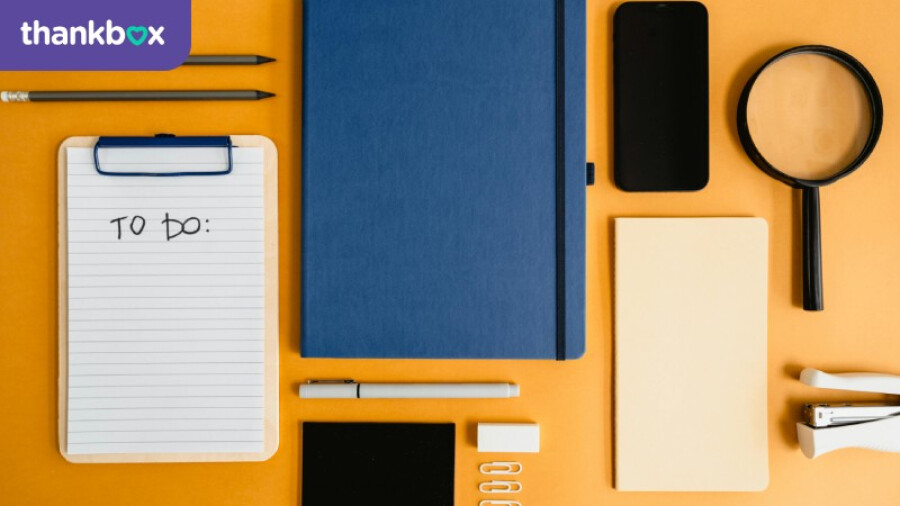How to Tackle Your To-Do List: Simple Tips for Prioritising Your Workload


You know that feeling when your to-do list starts looking more like a novel than a simple agenda? We’ve all been there—staring at a mountain of tasks and wondering if it’s too late to move to a deserted island.
But before you start Googling “cheap island real estate,” let’s talk about how to actually tackle that list—without losing your sanity.
The truth is, managing your workload doesn’t have to be stressful or complicated. With a few simple strategies, you can prioritise your tasks and make your 9-to-5 go from chaos to clarity.
Whether you’re juggling multiple projects, buried in emails, or just trying to squeeze in a coffee break, Thankbox has practical tips to help get you started. Let’s dive in!
Why prioritising your workload matters
We all get the importance of planning ahead, especially when it comes to handling our workload. But planning isn’t just about jotting down tasks—it’s about figuring out what needs to be tackled first.
Strategic planning goes hand-in-hand with a productive day. By clearly defining your priorities, you can allocate your time strategically and focus on what matters—taking your work performance to the next level.
On the flip side, poor planning—or none at all—often leads to a chaotic workday chock-full of constant firefighting and last-minute scrambling. This reactive mode increases stress and diminishes work quality, often resulting in an unhealthy work-life balance.
Streamline your tasks by focusing on what truly matters. Create a Thankbox today to appreciate the people around you who make a difference and celebrate each success along the way!
Top 9 tips for prioritising your workload
Staying clear-headed in a busy office can be difficult. Thankfully, prioritising your workload is a great step forward. Let’s take a look at some top tips:
1. Start with a task unload
The first step in getting your workload under control is to get everything out of your head and onto paper (or a digital tool). This process is called a “task unload,” and it’s exactly what it sounds like—unloading every task, idea, and responsibility you have into one place.
Don’t worry about the order of importance—the goal is to clear your mind and create a list of everything that needs attention. This will give you an idea of what you’re dealing with so you can begin to organise and prioritise.
2. Categorise your tasks

Once you’ve completed the above, the next step is to categorise. Group similar tasks together—such as emails, meetings, reports, or client work—and then identify the nature of each task—urgent, important, or routine.
By categorising, you’ll start to see patterns and determine which areas require the most attention. This step breaks down your workload into more manageable chunks, making it easier to focus while boosting productivity.
3. Apply the Eisenhower Matrix
Now that your tasks are categorised, it’s time to apply the Eisenhower Matrix, a popular tool for prioritising based on urgency and importance. The matrix divides tasks into four sections:
Urgent and important (do first)
Important but not urgent (schedule)
Urgent but not important (delegate)
Neither urgent nor important (eliminate or defer)
Now, you can quickly identify what needs immediate action, what you can schedule for later, what you can delegate to someone else, and what might not need your attention at all.
4. Set time limits
When assigning tasks a specific amount of time, you create a sense of urgency that helps you maintain focus. This method, known as time blocking, prevents tasks from dragging on longer than necessary.
For instance, if you allocate 30 minutes for responding to emails, stick to that time limit and move on to the next task once the time is up. This helps you make the most of your workday.
5. Focus on one task at a time
While being able to multitask is seen as a plus, focusing on one task at a time is surprisingly powerful. When you give your full attention to a single project, you’re more likely to complete it quickly and with better quality.

Unexpectedly, multitasking can lead to mistakes and missed details. Instead, try to block out distractions, set aside time, and commit to seeing it through before moving on to what’s next.
If you’re a remote worker, where distractions can be commonplace, check out our article “Boost Your Remote Working Skills with These 15 Tips.”
6. Identify your peak productivity hours
Everyone has certain times of the day when they’re naturally more alert. Identifying your peak productivity hours allows you to schedule your most important or challenging tasks effectively.
Pay attention to when you’re most energised and clear-headed, and plan your workday around these periods. Trust us, stick with it, and you’ll start building better habits in no time.
Streamline your tasks by focusing on what truly matters. Create a Thankbox today to appreciate the people around you who make a difference and celebrate each success along the way!
7. Implement the two-minute rule
The two-minute rule is a simple yet effective strategy for handling small tasks. The idea is straightforward—if you can complete a task in two minutes, do it immediately. This helps prevent minor tasks from piling up and taking up valuable mental space.
Whether replying to a quick email, filing a document, or jotting down a note, instantly tackling these minor tasks keeps you ready for more pressing work.
8. Learn to say no to low-priority tasks
Knowing when to say no is one of the most valuable skills in managing your workload. It’s easy to get overwhelmed by tackling too many things, especially when they don’t contribute to your main goals.
By politely declining or delegating, you free up time and energy for what truly matters. Remember, every time you say yes to something, you’re saying no to something else.
9. Reward yourself
After completing a task, take a moment to reward yourself. It doesn’t have to be something big—a small treat is enough to keep you motivated. And it doesn’t have to end there. When you check off a big task, why not share the good vibes by rewarding others?

Sending a Thankbox online group card is the perfect way to show appreciation to someone who’s made a difference. Whether they had your back through a challenging project or just brightened your day, a Thankbox lets you say thank you in a personal and meaningful way.
It’s easy to set up, and the best part is that everyone on your team can contribute. You can also add a digital gift card or flower delivery. So, the next time you achieve something big, reward yourself and share the love with Thankbox.
Wrapping up
By prioritising your workload, setting clear goals, and using simple strategies like time blocking and the two-minute rule, you’ll transform a chaotic workday into a productive one.
Remember, it’s not just about getting things done—it’s about working smarter.
And don’t forget to celebrate your wins, both big and small. Rewarding yourself and appreciating others can make all the difference in maintaining a positive workplace.
Create a Thankbox today and celebrate every success.
Images: Cover | Woman coding on a computer | Motivated team





